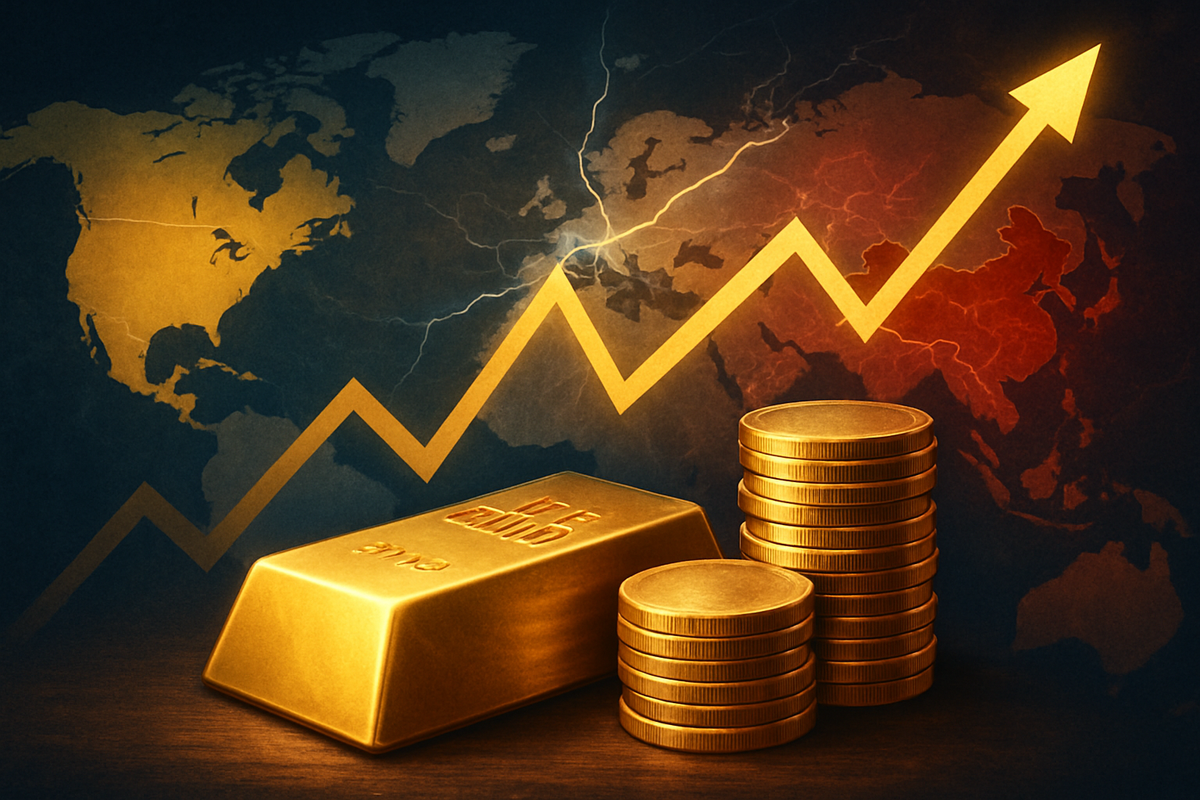
Gold has shattered records, surging above an unprecedented $4,000 per ounce, marking its eighth consecutive week of gains as of October 10, 2025. This historic rally is largely fueled by a potent mix of escalating geopolitical tensions, persistent economic uncertainties, and a significant new catalyst: former President Donald Trump's renewed threat of "massive" tariffs on China. The precious metal's ascent underscores a profound shift in investor sentiment, as market participants increasingly seek safe haven assets amidst a turbulent global landscape.
The yellow metal's remarkable performance reflects a deepening anxiety across financial markets, with investors flocking to gold as a bulwark against inflation, currency debasement, and widespread instability. Trump's latest declaration, accusing Beijing of "very hostile" moves and hinting at a potential cancellation of a meeting with Chinese President Xi Jinping, has reignited fears of a full-blown trade war, amplifying the demand for gold and sending shockwaves through global supply chains and equity markets. This confluence of factors paints a picture of a market bracing for further volatility, with gold emerging as the undeniable beneficiary of the current climate of apprehension.
An Unprecedented Ascent: Gold's Journey to $4,000 and Beyond
Gold's journey to and beyond the $4,000 per ounce mark is a testament to the profound shifts occurring in the global economic and geopolitical arena. The metal recently topped $4,050 and even touched an all-time high of $4,059.05 on October 9, 2025, representing a staggering 50-53% increase since the beginning of the year. This sustained rally is not merely a fleeting moment but a culmination of several intertwined developments, creating what analysts describe as a "toxic cocktail of pressures" driving investors towards the ultimate safe-haven asset.
The timeline leading up to this moment has been characterized by persistent global instability. Lingering conflicts in the Middle East and the ongoing Russia-Ukraine war continue to cast a long shadow, fostering an environment of geopolitical risk. Domestically, in the U.S., an ongoing government shutdown and growing concerns over the sustainability of government debt levels have further eroded confidence in traditional financial instruments. These factors, combined with stubbornly high inflation rates in major economies and expectations of the Federal Reserve entering an interest rate cutting cycle, have made gold an increasingly attractive hedge against economic uncertainty and potential currency debasement.
Key players in this scenario include global central banks, which have been significant buyers of gold, diversifying their reserves away from traditional currency holdings. Institutional investors have also dramatically shifted their allocations, evidenced by record inflows into gold-backed Exchange Traded Funds (ETFs). On the political front, Donald Trump's re-emergence with aggressive trade rhetoric against China has acted as a potent and immediate catalyst. His threat of "massive" tariffs, following China's new export policy restricting rare earths and imposing additional port fees on U.S. shipments, directly reignites memories of the 2018-2019 trade war, during which gold prices surged by 15%.
Initial market reactions to gold's surge have been varied. While gold mining stocks are experiencing a boom, other sectors, particularly those reliant on global trade and stable supply chains, are facing renewed uncertainty. The U.S. dollar has shown weakness, making gold more attractive to international buyers. Furthermore, the significant outperformance of gold compared to major U.S. stock indices like the Dow Jones (NYSE: DIA), S&P 500 (NYSEARCA: SPY), and Nasdaq Composite (NASDAQ: QQQ) in 2025 highlights a broader reallocation of capital, signaling a cautious approach from investors wary of equity market volatility.
Corporate Fortunes Shift: Winners and Losers in a Volatile Market
The dual forces of surging gold prices and intensifying U.S.-China trade tensions are creating a clear delineation of winners and losers across the corporate landscape. As gold maintains its position above $4,000/oz, companies involved in its extraction and associated financial services are reaping substantial benefits, while industries reliant on gold as a raw material face significant cost pressures. Simultaneously, the renewed threat of tariffs is accelerating a global supply chain realignment, favoring domestically focused manufacturers and logistics providers, while penalizing those with deep ties to the Chinese market.
Gold mining companies stand as the most direct beneficiaries of the precious metal's unprecedented rally. With gold prices significantly exceeding their "all-in sustaining costs" (AISC), miners are experiencing exponential growth in revenues, cash flows, and profit margins. Companies such as Alamos Gold (NYSE: AGI, TSX: AGI), with projected 2025 production between 580,000 to 630,000 ounces, are seeing substantial financial gains. Similarly, major players like AngloGold Ashanti (NYSE: AU, ASX: AGG) and Kinross Gold (NYSE: KGC, TSX: K) are poised for improved financial performance and potentially increased dividends. Furthermore, gold-backed Exchange-Traded Funds (ETFs) are witnessing record inflows, and streaming and royalty companies, which finance miners in exchange for future production, are also benefiting immensely from the elevated gold prices.
Conversely, industries that depend on gold as a critical raw material are facing considerable headwinds. Jewelry retailers and manufacturers, including brands like Pandora and Signet Jewelers, are absorbing significantly higher input costs, which can compress profit margins and force price increases, potentially dampening consumer demand. Similarly, electronics manufacturers such as Apple Inc. (NASDAQ: AAPL) and Samsung Electronics Co., Ltd. (KRX: 005930), which utilize gold in connectors and circuit boards, will see their production costs rise. The solar panel and electric vehicle (EV) sectors, with companies like First Solar, Inc. (NASDAQ: FSLR) and Tesla, Inc. (NASDAQ: TSLA) using gold and silver in components, are also grappling with increasing material expenses.
The re-escalation of U.S.-China trade tensions is driving a significant push towards "reshoring" and "nearshoring" of manufacturing. This trend is a boon for logistics real estate companies like Prologis (NYSE: PLD), the world's largest owner of logistics real estate, which will see increased demand for warehouses in the U.S. and Mexico. Logistics software providers such as Manhattan Associates (NASDAQ: MANH) and global carriers like United Parcel Service (UPS) (NYSE: UPS) are also well-positioned to benefit from the complex supply chain adjustments. Industrial and manufacturing companies with a strong domestic focus, including Intel (NASDAQ: INTC), Caterpillar (NYSE: CAT), Rockwell Automation (NYSE: ROK), and Honeywell International (NASDAQ: HON), are more insulated from tariff impacts and can capitalize on government incentives aimed at strengthening American manufacturing.
However, companies with significant exposure to the Chinese market, either through sales or intricate supply chains, are facing severe challenges. Technology giants like Qualcomm (NASDAQ: QCOM), which derives 64% of its revenue from China, and Micron Technology (NASDAQ: MU), with 55% of its revenue from China, are vulnerable to export restrictions, supply chain fragmentation, and potential boycotts. Apple (NASDAQ: AAPL), despite its global reach, relies heavily on China for both sales (around 16% of revenue) and manufacturing. Furthermore, a wide array of consumer goods retailers, including e.l.f. Beauty (NYSE: ELF), Steven Madden (NASDAQ: SHOO), and Five Below (NASDAQ: FIVE), which source a significant portion of their products from China, face increased costs due to tariffs, potentially leading to higher consumer prices or reduced profit margins. The automotive sector, with companies like Ford (NYSE: F) and Tesla (NASDAQ: TSLA) having considerable exposure to Chinese partners and supply, also faces significant disruption.
A Shifting Global Paradigm: Deeper Implications of Gold's Ascent and Trade Friction
The simultaneous surge of gold prices above $4,000/oz and the re-ignition of U.S.-China trade tensions represent more than just market fluctuations; they signal a profound and potentially lasting shift in the global economic and geopolitical landscape. These events are not isolated but rather deeply interconnected, creating a feedback loop that exacerbates global fragility and reshapes fundamental industry trends, policy considerations, and investment strategies.
One of the most significant broader industry trends is the redefinition of gold as an "asset for all occasions." Its consistent outperformance during periods of both risk aversion and, surprisingly, even alongside some equity rallies, positions it as a crucial hedge against a spectrum of uncertainties, from geopolitical conflicts and government shutdowns to inflation and currency debasement. This has led to recommendations for increased gold allocations in investor portfolios, with some experts suggesting 10-15% for stability. The ripple effect is evident in the shift of capital, with record inflows into gold ETFs and robust central bank demand globally, reflecting a strategic move away from traditional Western currency holdings. This trend underscores a growing lack of confidence in fiat currencies and a desire for tangible, independent stores of value.
The regulatory and policy implications are far-reaching. Central banks face an increasingly complex challenge of balancing persistent above-target inflation with the need to support weakening labor markets. The Federal Reserve's pivot to interest rate cuts in 2025, while intended to cushion economic impacts, is now complicated by the inflationary pressures exerted by tariffs. The aggressive accumulation of gold by central banks, particularly in Asia and the Middle East, signals a broader geopolitical rebalancing and a desire for greater monetary independence, which could influence future global monetary policy frameworks. Furthermore, the reliance on erratic trade policies, as seen with Trump's tariff threats, undermines long-term economic resilience and U.S. global leadership, fostering an environment where trade is increasingly used as a tool of power.
Historically, gold has proven its mettle during times of crisis. During the Great Depression (1929-1939), it served as a safe investment. Its price soared after the abandonment of the gold standard in 1971, driven by oil crises and high inflation, reaching $850/oz by 1980. More recently, gold surged during the Global Financial Crisis (2008-2009) and the COVID-19 pandemic (2020), consistently demonstrating its countercyclical appeal and its ability to act as a reliable store of value when equities falter. The current trade war echoes the Smoot-Hawley Act of the 1930s, which led to retaliatory tariffs, a collapse in global trade, and deepened the Great Depression, as well as the U.S.-China trade war of 2018-2020, which similarly disrupted supply chains and slowed global economic growth. These historical precedents highlight the potential for severe economic consequences arising from escalating trade protectionism. The current situation, with gold's surge and trade tensions, points to a systemic shift towards greater geopolitical fragmentation, re-evaluation of supply chains, persistent inflationary pressures, and a re-prioritization of tangible assets like gold as fundamental stores of value in an increasingly volatile world.
The Road Ahead: Navigating a New Era of Volatility and Opportunity
The unprecedented surge in gold prices and the escalating U.S.-China trade conflict are not fleeting events but harbingers of a new, more volatile global economic landscape. Looking ahead, both the trajectory of gold and the nature of international trade relations will be shaped by ongoing geopolitical tensions, evolving monetary policies, and strategic national pivots, presenting both significant challenges and unique opportunities for investors and businesses alike.
In the short term (October 2025 - Early 2026), gold's remarkable ascent above $4,000/oz, reaching intra-day highs of $4,014.60, may face a period of consolidation or even a minor correction. Some analysts suggest a 10-15% pullback is possible, especially if technical indicators like the Relative Strength Index (RSI) signal an overbought market or if there are temporary de-escalations in geopolitical tensions, such as a sustained ceasefire in the Middle East. However, the underlying drivers of gold's rally – global economic uncertainty, geopolitical risks, and expectations of Federal Reserve interest rate cuts – are expected to remain potent, providing strong fundamental support. For U.S.-China trade relations, the immediate future is likely to see an intensification of bilateral restrictions, with expanded U.S. export controls on critical technologies and anticipated Chinese retaliation through limits on critical mineral exports and tighter regulatory controls. Diplomatic channels are expected to remain open, but any de-escalation is likely to be sporadic and tactical rather than a fundamental shift.
The long-term outlook (2026 and beyond) for gold remains overwhelmingly bullish. Major financial institutions like J.P. Morgan Research, ING, and Goldman Sachs have significantly raised their forecasts, with targets ranging from an average of $4,150/oz in 2026 to an optimistic $4,900/oz by the end of 2026. These projections are underpinned by persistent geopolitical instability, continued economic uncertainty, a weaker U.S. dollar, sustained central bank purchases, and gold's enduring role as an inflation hedge. For U.S.-China trade, the long-term prognosis points towards "managed competition" or even further "de-coupling." The U.S. will likely continue its "America First" agenda, prioritizing domestic investment and reducing reliance on Chinese supply chains, particularly in critical sectors like semiconductors and AI. China, in turn, is accelerating its diversification strategies, expanding trade networks through initiatives like the Belt and Road Initiative and strengthening domestic consumption through its "dual circulation" strategy.
Potential strategic pivots for businesses include accelerating "China+1" supply chain strategies, diversifying manufacturing to countries like Vietnam, India, and Mexico, and investing heavily in domestic production capabilities. Market opportunities abound for companies facilitating reshoring, such as logistics real estate firms and industrial automation providers. Conversely, challenges will persist for multinational corporations navigating fragmented global trade systems, increased compliance complexities, and higher operational costs. Potential scenarios range from continued escalation of the trade war, leading to a more fragmented global economy and strong sustained support for gold, to "managed competition" with sporadic de-escalations that might temporarily ease safe-haven demand for gold. A third scenario involves the regionalization of trade blocs, where both superpowers prioritize strengthening trade within their spheres of influence, creating a more complex and potentially less interconnected global trade system. This intricate interplay between trade tensions and gold prices suggests that as long as the U.S.-China relationship remains contentious, gold will likely find sustained support as a critical hedge against uncertainty.
The Golden Standard in an Age of Uncertainty: A Comprehensive Wrap-Up
The financial world stands at a pivotal juncture, marked by gold's unprecedented surge past the $4,000 per ounce threshold and the re-ignition of intense U.S.-China trade hostilities. As of October 10, 2025, these interwoven events underscore a profound re-evaluation of security and stability in global finance, cementing gold's role as the quintessential safe-haven asset in an increasingly unpredictable world.
Key Takeaways: Gold's meteoric rise, achieving its 40th record price milestone in 2025 alone, is not the result of a singular factor but a "perfect storm" of economic and geopolitical forces. Persistent global conflicts, including those in Ukraine and Gaza, coupled with domestic political uncertainties, have fueled a pervasive sense of risk. The renewed U.S.-China trade war, characterized by escalating tariffs and restrictions on critical technologies and minerals, has further amplified global economic uncertainty. Simultaneously, a weakening U.S. dollar and persistent inflation concerns have made gold an attractive hedge against currency debasement and erosion of purchasing power. A critical structural driver is the unprecedented and sustained accumulation of gold by central banks worldwide, particularly in emerging markets, signaling a strategic diversification away from traditional dollar-denominated reserves. This confluence of factors has not only driven gold prices to historic highs but also prompted a discernible shift in investment portfolios towards a long-term strategic allocation to the yellow metal.
Market Assessment Moving Forward: While the market outlook for gold remains broadly bullish, caution regarding short-term volatility is warranted. Major financial institutions project continued strength, with ING forecasting an average of $4,150/oz in 2026 and Goldman Sachs targeting nearly $4,900/oz by December 2026. However, some analysts suggest that gold's rapid ascent may indicate an "overbought" market, making a healthy short-term correction of 10-15% a possibility. The broader global economy, as projected by the World Bank, faces a slowdown to 2.3% growth in 2025, primarily due to escalating trade tensions, policy uncertainty, and geopolitical risks. The structural issues driving U.S.-China competition are deep-seated, implying that trade relations will remain complex and volatile, leading to ongoing disruptions in global supply chains and economic growth.
Significance and Lasting Impact: The current gold surge and persistent U.S.-China trade tensions signify a fundamental re-evaluation of security and stability in global finance. Gold is increasingly perceived as the "ultimate store of value" and a crucial hedge against the multifaceted risks prevalent in today's environment. The unprecedented central bank demand for gold represents a structural shift in the global financial architecture, as nations seek to diversify away from traditional reserve currencies and assert greater monetary independence. The ongoing trade disputes, meanwhile, contribute to a more fragmented global economy, with long-term implications for supply chains, inflation, and international cooperation. This era is defined by "geoeconomics," where trade is wielded as a tool of power, further complicating economic forecasts and policy responses.
What Investors Should Watch For: In the coming months, investors must remain vigilant and monitor several key indicators. Developments in U.S.-China trade dialogue, including any tariff negotiations or further escalations, will directly impact market sentiment and global economic stability. The trajectory of existing geopolitical flashpoints and the emergence of new tensions will continue to influence safe-haven demand for gold. Actions by major central banks, particularly the Federal Reserve's stance on interest rates and monetary easing, will be critical, as expectations of easing typically support gold prices. Sustained high inflation figures will continue to bolster gold’s appeal as an inflation hedge, while the performance of the U.S. dollar will impact gold's attractiveness to international buyers. Finally, continued monitoring of official sector gold purchases will provide insights into the ongoing structural shift in reserve management, and investors should also keep an eye on technical indicators that might signal short-term corrections in gold prices amidst its strong long-term fundamentals.
This content is intended for informational purposes only and is not financial advice





